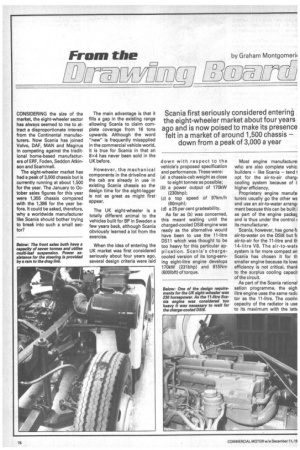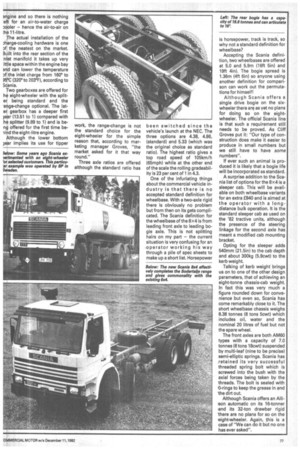1 w ( f LLD
Page 60

Page 61

If you've noticed an error in this article please click here to report it so we can fix it.
by Graham Montgomerk
Scania first seriously considered entering the eight-wheeler market about four years ago and is now poised to make its presence felt in a market of around 1,500 chassis — down from a peak of 3,000 a year
CONSIDERING the size of the market, the eight-wheeler sector has always seemed to me to attract a disproportionate interest from the Continental manufacturers. Now Scania has joined Volvo, DAF, MAN and Magirus in competing against the traditional home-based manufacturers of ERF, Foden, Seddon Atkinson and Scam melt.
The eight-wheeler market has had a peak of 3,000 chassis but is currently running at about 1,500 for the year. The January to October sales figures for this year were 1,355 chassis compared with the 1,386 for the year before. It could be asked, therefore, why a worldwide manufacturer like Scania should bother trying to break into such a small sector? The main advantage is that it fills a gap in the existing range allowing Scania to claim complete coverage from 16 tons upwards. Although the word "new" is frequently misapplied in the commercial vehicle world, it is true for Scania in that an 8x4 has never been sold in the UK before.
However, the mechanical components in the driveline and the cab are already in use in existing Scania chassis so the design time for the eight-legger is not as great as might first appear.
The UK eight-wheeler is a totally different animal to the vehicles built for BP in Sweden a few years back, although Scania obviously learned a lot from the exercise.
When the idea of entering the UK market was first considered seriously about four years ago, several design criteria were laid down with respect to the vehicle's proposed specification and performance. These were: (a) a chassis-cab weight as close to eight tonnes as possible; (b) a power output of 170kW (230bhp); (c) a top speed of 97km/h (60mph); (d) a 25 per cent gradeability.
As far as (b) was concerned, this meant waiting until the charged-cooled DSi8 engine was ready as the alternative would have been to use the 11-litre DS11 which was thought to be too heavy for this particular application. Scania's chargecooled version of its long-serving eight-litre engine develops 170kW (231bhp) and 815Nm (600Ibft) of torque.
Most engine manufacture' who are also complete vehicl builders — like Scania — tend I opt for the air-to-air chargl cooling system because of ii higher efficiency.
Proprietary engine manufai turers usually go the other wa and use an air-to-water arrangi ment because this can be built i as part of the engine packag and is thus under the control c its manufacturer.
Scania, however, has gone ft air-to-water on the DS18 but ft air-to-air for the 11-litre and th 14-litre V8. The air-to-watE system is far more compact an Scania has chosen it for th smaller engine because its lowE efficiency is not critical, thank to the surplus cooling capacit of the circuit.
As part of the Scania rational sation programme, the eigh litre engine uses the same radii tor as the 11-litre. The coolin capacity of the radiator is use to its maximum with the lam 3e engine and so there is nothing left for an air-to-water charge :ooler — hence the air-to-air on the 11-litre.
The actual installation of the :harge-cooling hardware is one pf the neatest on the market. lit into the rear section of the et manifold it takes up very le space within the engine bay d can lower the temperature the inlet charge from 160° to 95°C (320° to 203°F), according to Scania.
Two gearboxes are offered for h eight-wheeler with the splits being standard and the ailige-change optional. The late gearbox has a deeper first je r (13.51 to 1) compared with :h0 splitter (9.89 to 1) and is beng offered for the first time be
d the eight-litre engine.
Although the lower bottom ar implies its use for tipper work, the range-change is not the standard choice for the eight-wheeler for the simple reason that, according to marketing manager Groves, "the market asked for it that way round."
Three axle ratios are offered although the standard ratio has been switched since the vehicle's launch at the NEC. The three options are 4.38, 4.86, (standard) and 5.33 (which was the original choice as standard ratio). The highest ratio gives a top road speed of 105km/h (65mph) while at the other end of the scale the rolling gradeability is 23 per cent of 1 in 4.3.
One of the infuriating things about the commercial vehicle industry is that there is no accepted standard definition for wheelbase. With a two-axle rigid there is obviously no problem but from then on its gets complicated. The Scania definition for the wheelbase of the 8x4 is from leading front axle to leading bogie axle. This is not splitting hairs on my part — the current situation is very confusing for an -operator working his way through a pile of spec sheets to make up a short list. Horsepower is horsepower, track is track, so why not a standard definition for wheelbase?
Accepting the Scania definition, two wheelbases are offered at 5,0 and 5.9m (16ft 5in) and 19ft 4in), The bogie spread is 1.36m (4ft 61n) so anyone using another definition for comparison can work out the permutations for himself!
Although Scania offers a single drive bogie on the sixwheeler there are as yet no plans for doing so on the eightwheeler. The official Scania line is that such a requirement still needs to be proved. As Cliff Groves put it: "Our type of construction does make it easier to produce in small numbers but we still have to have some numbers".
If ever such an animal is produced it is likely that a bogie life will be incorporated as standard.
A surprise addition to the Scania list of options for the 8 x4 is a sleeper cab. This will be available on both wheelbase variants for an extra £840 and is aimed at the operator with a longdistance bulk operation. It is the standard sleeper cab as used on the '82 tractive units, although the presence of the steering linkage for the second axle has meant a modified cab mounting bracket.
Opting for the sleeper adds 540mm (21.5in) to the cab depth and about 300kg (5.9cwt) to the kerb weight.
Talking of kerb weight brings us on to one of the other design parameters, that of achieving an eight-tonne chassis-cab weight. In fact this was very much a figure rounded down for convenience but even so, Scania has come remarkably close to it. The short wheelbase chassis weighs 8.38 tonnes (8 tons 5cwt) which includes oil, water and the nominal 20 litres of fuel but not the spare wheel.
The front axles are both AM60 types with a capacity of 7.0 tonnes (6 tons 18cwt) suspended by multi-leaf (nine to be precise) semi-elliptic springs. Scania has retained its very successful threaded spring bolt which is screwed into the bush with the axial forces being taken by the threads. The bolt is sealed with !CI-rings to keep the grease in and The dirt out.
Although Scania offers an Allison automatic on its 16-tonner .and its 32-ton drawbar rigid 'there are no plans for so on the eight-wheeler. Again, this is a case of "We can do it but no one has ever asked".
































































